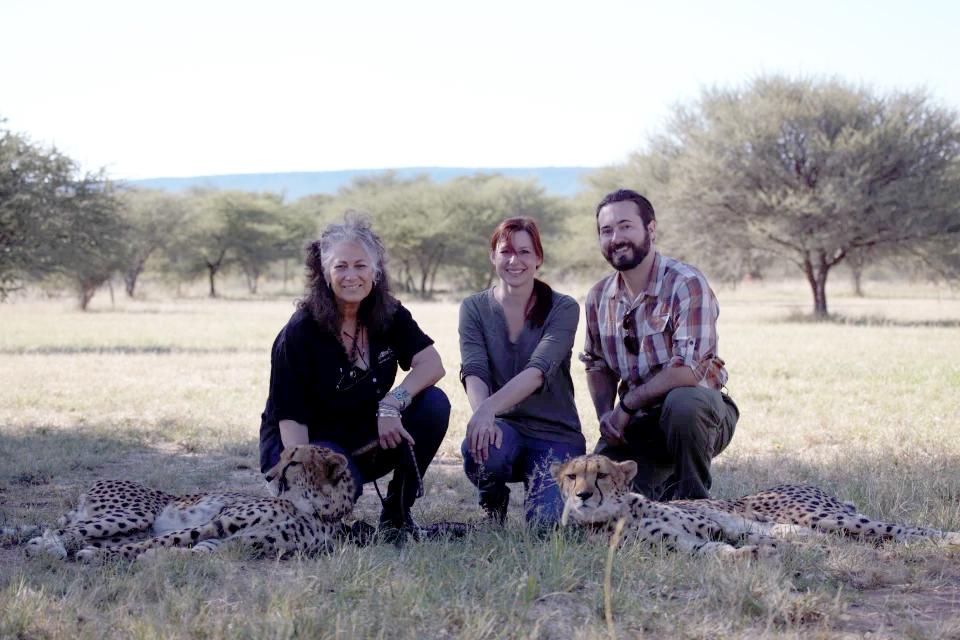SUNY Oswego cinema and screen studies faculty members Tiffany Deater (center) and Jarrod Hagadorn (right) are part of a select team taking part in the American Association of State Colleges and Universities’ Stewardship of Public Lands program, an initiative of AASCU’s American Democracy Project. Conservation filmmaking and activities ahve been a big part of their work; here they are shown with Laurie Marker, founder and director of the Cheetah Conservation Fund, and a pair of resting cheetahs.
SUNY Oswego cinema and screen studies faculty members Tiffany Deater and Jarrod Hagadorn are among a select group that will take part in the American Association of State Colleges and Universities (AASCU)’s Stewardship of Public Lands program, an initiative of AASCU’s American Democracy Project.
The year-long Stewardship of Public Lands program aims to foster innovative regional collaborations, responsible stewardship practices and experiential learning by bringing a variety of higher education practitioners to Glacier National Park to collaborate on overlapping projects.
For the filmmaking couple – who live in a log home surrounded by forest land – this opportunity is perfect for their interests and skills.
“It really is about stewardship,” Hagadorn noted. “Tiffany and I have been talking about that term a lot lately.”
One of their most recent projects was a collaboration with student filmmakers, faculty and land stewards to create a well-received 16-minute documentary on the creation and history of the nearby Sterling Nature Center.
When Jennifer Knapp, dean of the School of Communication, Media and the Arts, sent along the opportunity, “we said this looks a lot like what we’re doing so we thought we should apply,” Deater recalled.
Twenty-two participants, representing 14 institutions from 12 states, will apply strategies to spark thoughtful discourse and an appreciation of national parks within curricular and cocurricular opportunities for university students of all backgrounds. The design of the program is to build a diverse community of university faculty, staff and leaders who can promote access to national parks as grounds for studying sustainability, learning from Indigenous and community members, and building civic skills.
“The Stewardship of Public Lands program enables our cohort to explore multiple perspectives on how to appreciate and understand our natural resources, build bridges that foster collaboration and share their work and commitment with our AASCU campuses,” said Terry Brown, AASCU’s vice president of academic innovation and transformation.
Film projects
“In particular, what we’ll be doing there is a couple of film projects,” Hagadorn said. “One is an overview of the program, but with a personal approach as to why they are doing it.”
They connected with the other members of the cohort, and they were all interested in contributing their stories to a larger documentary effort.
“The final project Tiffany and I want to make is a short film that shows all these people, what they’re doing here, what the common thread is,” Hagadorn said. “What does it mean to the rest of the world? What does it mean to us as professionals? Why is it worth doing?”
“It was unanimous that everybody wanted to participate,” Deater said. “That means there will be 20 different stories coming in. We will get to see what they value.”
“Everyone seems really good, friendly and willing to talk,” Hagadorn said. “The final project is going to depend on what that common thread is.”
The location is significant because the reintroduction of bison to Glacier National Park has already sparked conversations that touch on much larger themes of conservation, stewardship and climate change, Deator said.
“This project incorporates listening to everybody having these conversations,” Deater said. “It involves listening to each other and how we mediate conflict.”
“We’ll be on location for a minimum of one week,” Hagadorn said. “There is a short residency at the park in June. We will stay in rustic cabins. They’re owned by the park. I get the impression that it’s fairly remote, which is great.”
They also would like to see the impact of climate change, which is not necessarily as evident in Central New York but is more noticeable at Glacier National Park.
“We want to see glaciers,” Hagadorn said. “We know that glaciers are receding. We want to learn more about glacier science.”
The project provides an excellent opportunity to use their talents where professional and personal passions overlap.
“We’ll make a nice documentary that we can share with our cohort and the organizers of the Stewardship of Public Lands program, which they can share with the public,” Deater said. “And we can help develop experiential learning in the park. We would love to have a summer course that could bring students there someday.”
“We want to make sure the work we create gives people an opportunity to love the things that we also love,” Hagadorn said. “We’d like this video to encourage people to love our natural world more. We’ve got to build connections. On a personal note, I think that’s what our work is to build connections between people and the natural world, to make them love it more.”




